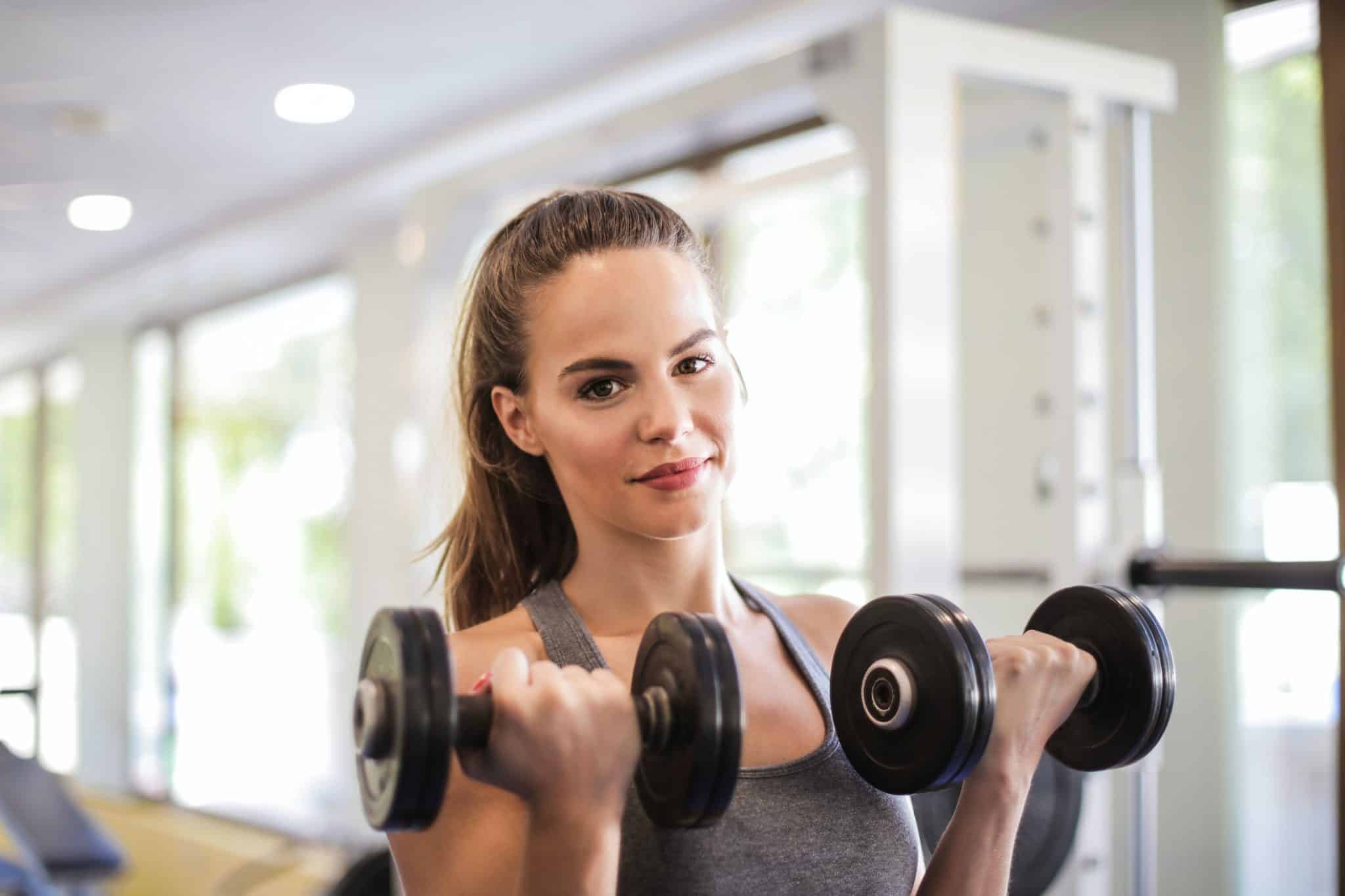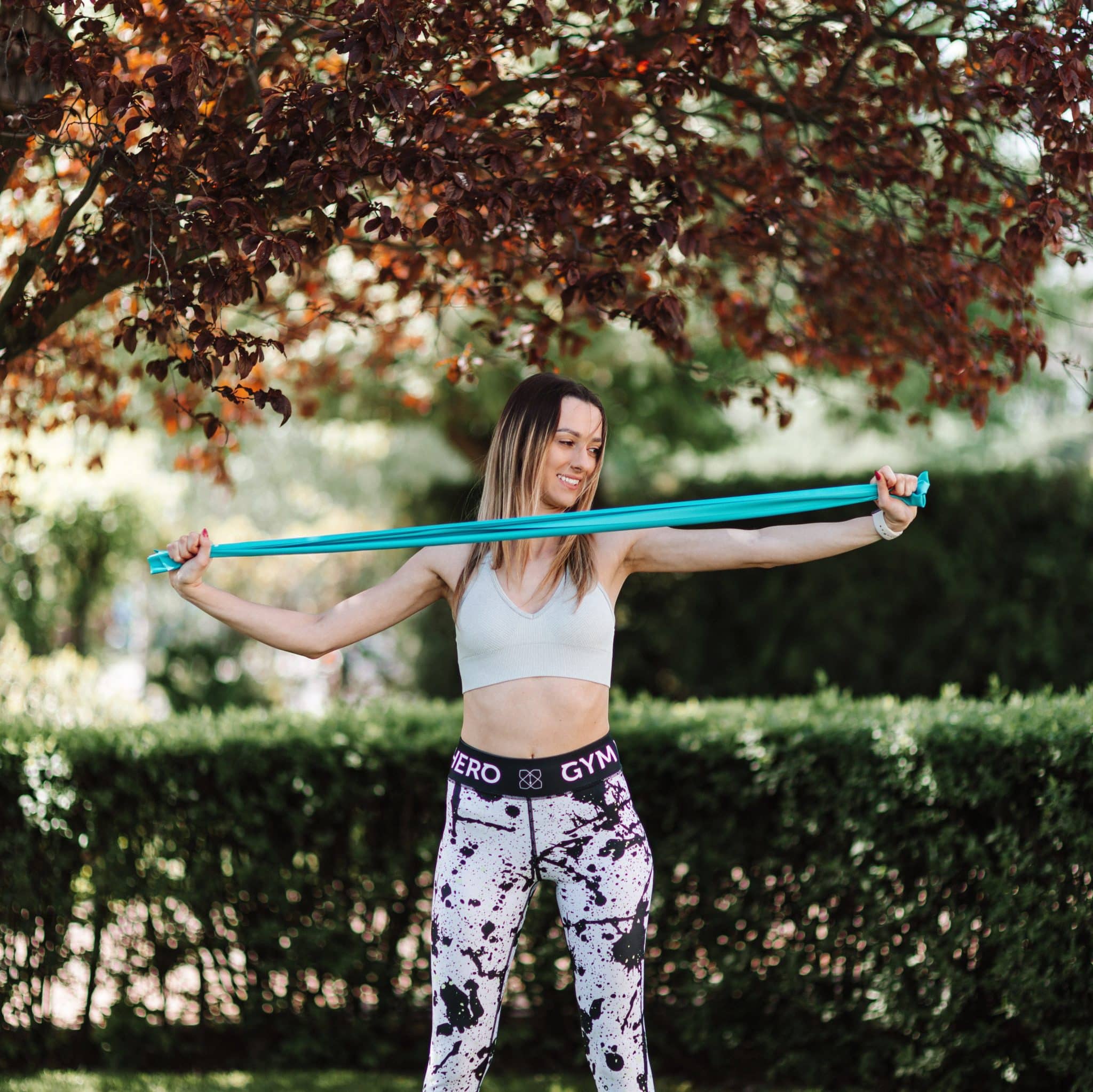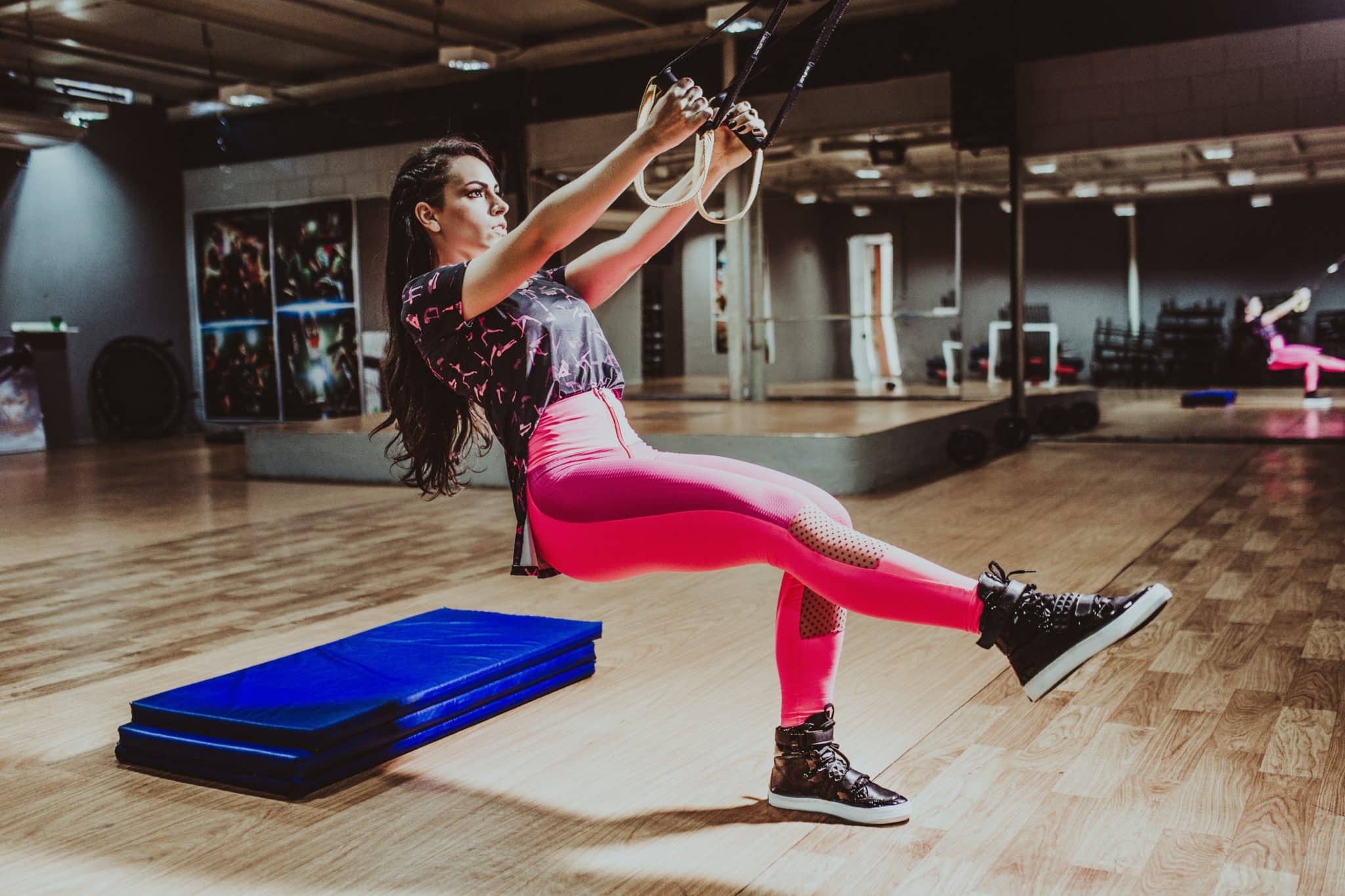If you’re like most people, you know strength training is good for you. You see the results others have achieved. You’ve probably even tried it in the past. But let’s face it, short of pumping out a few bicep curls, starting a strength training routine can be intimidating and confusing. Walk onto any weight floor in the gym and it seems everyone there has a plan and knows what they’re doing but you! Of course, the truth is that everyone had to start as a beginner at one time. That’s why we created this beginner strength training guide for women.
You’re about to embark on one of the best decisions you’ve ever made for your body: strength training. So let’s get started!
Use the guide below to quickly navigate this article:
- How Does Strength Training Work?
- Benefits of Weight Training for Women
- How to Get Started
- Strength Training for Women FAQs
- Strength Training Glossary
- Safety Tips For Strength Training Workouts
- How to Take Your Strength Training to the Next Level
How Does Strength Training Work?
When you stress your muscles during a strength training workout, your muscles micro-tear and therefore need to rebuild themselves. As the repair in the muscle micro-tears takes place, the tissue layers itself growing stronger than it was before.
This process lasts for 72 hours following a challenging weight training session. This is why we don’t recommend strength training on back-to-back days unless you work different body parts on consecutive days of the week.
It is during the rest time that your muscles repair themselves and grow stronger. And don’t forget: a key part of this repair includes good nutrition. Make sure after you strength train that you take in the proper amount of protein, carbohydrates and healthy fat so as not to starve your muscle.
Benefits Of Weight Training for Women
Strength training is more than just getting firm and tight! The health benefits of weight training for women include a revved-up metabolism and so much more!
According to the Mayo Clinic, strength training can help you reduce body fat, increase lean muscle mass and burn calories more efficiently.
But the benefits go further! Strength training also:
- Builds muscle
- Speeds up metabolism
- Improves posture
- Increases bone density
- Decreases the risk of injury
- Decreases body fat
- Improves confidence and self-efficacy
- Improves quality of life
- Improves body mechanics including coordination, posture, flexibility and balance
Is that enough to convince you?! I would hope so! That’s why we say women of all ages—including those over 50—should practice weight training regularly. Remember: it’s never too late to start!
How To Get Started with Beginner’s Strength Training
After training thousands of women over several decades, I’ve put together the best beginner strength training tips to make sure you get started on the right foot.
1. Lift the Right Amount of Weight
When you initially start it off with around 12-15 reps per set. Go for a weight that is strong enough to challenge you but not so stiff that you’re losing the form.
You should feel challenged at the end of your sets, but the goal isn’t to raise your heart rate as you would during a cardio or HIIT session.
If you’re still not sure which dumbbell weight to use, check out my guide to learning when to increase your weights.
Think of strength movements like you’re sculpting your muscles. Tune into the mind-body connection.
2. Nail Down Your Form
For strength workouts, it’s so important to master the form. It’s a good idea to lean on a trainer to help. The good news is you can find great guided workout routines online for this without the hefty trainer pricetag.
It’s also a great practice to start using the mirrors in the gym (or your home mirror) to watch your form. Don’t forget to give yourself body-positive affirmations!
3. Schedule Regular Workouts But Don’t Overdo It
Doing too much too quickly is a common mistake in early weight training, especially for women. Women are wired to push hard and try to overachieve.
We are also used to the endorphin rush of cardio, so resistance training may feel like it’s not doing much right away.
Wait until a few days later. Your muscles will let you know! The soreness of weight training workouts sets in and you’ll know you pushed your muscles.
Workout Equipment For Strength Training
Strength training goes way beyond barbells and dumbbells, though those still stay at the top of the list as the most popular weight training tools for building muscle.
The great news is there are many more options to choose from if weights aren’t your thing. Bands, balls, sandbags—strength training is like a gym class when you were a kid except for way more fun!
And there likely is more than one way for you to accomplish your goals. Mix it up and use weights one day and something else the next time.
Think of strength training equipment as a playground, there is a ton of equipment that you can play with until you’ve found your match! Don’t limit yourself to one thing.
Let’s take a look at what some of your options are and the benefits of using each. Here are some of the most common pieces of equipment when it comes to strength training.
Barbells and Dumbbells

Dumbbells and barbells are the standard, have been around since the beginning, and will remain a staple for building muscle. Why? Because they work!
Usually, when you think of strength training, you think of weights. While bodyweight workouts still count as strength training, adding weights is a great way to up the ante.
Here are some reasons we love dumbbells and barbells:
- You can vary your weights to large degrees from 5-pound dumbbells to loading up for more than 100 pounds on a barbell.
- Great for all levels from beginners to experts
- You can pursue very small and big goals
- You can easily track your progress no matter how small the weight increases!
Adjustable vs. Fixed Dumbbells

There are two different types of dumbbells. The traditional dumbbells that you are used to seeing in a gym or in a fitness video might come to mind or adjustable dumbbells that are made to change up the same set of weights as needed for use at home.
So what is best for you? Here are some things to consider:
Adjustable weights
Adjustable dumbbells and weights are versatile and take up less space in your home because you are virtually using just one pair of dumbbells for everything. With interchangeable weights, you simply click a lever or pull a pin, add more weight or take it off, and your dumbbell changes just like that.
Think of a barbell and how you add plates on and off the end in order to adjust. This is the same concept only in a smaller form! Cool, right? Of course, it will cost you.
When you go to purchase adjustable weights there are several manufacturers to choose from. Do some shopping online to check them out.
A couple of the main brands include Powerblock which ranges from $150-$350 per pair as well as Bowflex which offers basic weights, high-tech “Bluetooth” weights and more ranging from $329-$529.
Both of these brands of adjustable dumbbells range from 5 pounds all the up to 90 pounds. Yup! You heard it! One pair and you can pretty much do it all!
Fixed dumbbells
Fixed weights on the other hand, are the more traditional option and a staple in a trainer’s collection of goodies. If you don’t mind having several pairs taking up space at home, these regular dumbbells are a cheaper option and allow you to purchase only what you need as you need it.
As you start your collection, you may start out with a set of 5 lb. and 8 lb. weights and in a few months you purchase another 10 lb. pair. Most of the traditional dumbbells, including the most popular brand SPRI, cost anywhere from $9-15 per pair.
If you go with the traditional dumbbell, you can choose soft, coated weights or metal and rubber, round-shaped ends or hexagon.
Rubber-coated weights are nice for the grip, especially as your hands get sweaty. They are softer to the touch and your hands are less likely to slip when wet. In addition, the softness makes it better for things you do in a plank position such as renegade rows where the metal center can be irritating or even painful to your palms. On the other hand, rubber-coated weights usually have round ends making them move around more in a plank position.
Traditional hexagon metal and rubber weights may be easier for some to grip in the center because although they are a harder surface they are a small circumference making it easier for small hands to hold and better for those who might have arthritis.
It’s based purely on personal preference so try them both before you decide.
Ready to put your new dumbbells to use? Try our at-home dumbbell chest workout!
Resistance Bands

Resistance bands come in various thicknesses and colors helping you to decide which level suits you and the exercise you are choosing. They are made to be pulled and stretched to create resistance in your muscles and make you stronger.
Here are some things we love about resistance bands:
- Light and portable, you can take these and work out pretty much anywhere!
- The bands are also fairly inexpensive and allow you to move in different motions than you can with weights.
- The band allows you to strengthen without lifting.
Ready to try them out? Be sure to check out our 7 resistance band moves for the whole body.
Suspension Trainers

These usually yellow straps that come in pairs and hang down allow you to use your own bodyweight to do amazing things! Put your feet in the straps or put your hands in the straps, it all depends on what you are doing.
Here are some reasons we love suspension trainers:
- You can get a full body workout, using your own body weight, and do everything from very beginner moves to exercises that will challenge a navy SEAL. (After all, it was a SEAL who invented them!)
- Small & light enough to easily store and even travel with.
- Pretty inexpensive
Ready to give it a try? Check out our beginner’s guide to TRX.
Stability Balls

Stability balls can be used alone for a great bodyweight workout, or combined with dumbbells or bands for more variety and challenge. These large balls were designed to enhance your balance. You sit on them, roll forward on them, or squat with them. These definitely make for a great full body workout.
Here are some reasons we love a stability ball:
- Teaches your body stability and balance.
- The ball can make moves more intense or be used to assist something and make it easier.
- They can also be used as a chair
Stability Ball Tip: Put it against the wall and lean back on the ball help with your squats, or lay face down on top, walk forward until only your feet are on the ball and you’ve got a super tough push up with balance training to boot.
Ready to try it out? Check out our stability ball total body toner workout!
Related: The Best Home Gym Equipment Under $40
Strength Machines

These machines found in most fitness facilities are designed to mimic the moves you do with weights, but with a bit more control from the device. If you want to use these you would certainly need to belong to a gym.
You may have heard machines criticized by some trainers because they don’t allow you to get the authentic training you get from free weights. But there are many benefits to strength machines! They have a place in the world of weight training.
Here are some reasons to love strength machines:
- Machines are a great choice for people who are new to strength training.
- Strength machines are excellent for those working out alone, lifting a lot of weight without a spotter.
- Machines are ideal for older adults who fear injury, deal with sciatica, hip bursitis, or want to avoid mishap that can occur more easily from free weights.
Strength Training for Women FAQs
Strength train at least three times a week for best results. Ultimately you can strength train every day if you really like it. The key is to get the proper rest for each individual muscle group in between. For instance, do your legs and chest one day and your back and arms the next day. You need 48 hours of rest for any body part you train. Most people, however, like to get everything done in one session, so three total-body strength sessions per week is a good solution.
Yes! Resistance training can reduce the risk of degenerative diseases and the overall quality of life. As we age, both our strength and metabolism decrease. That’s why it’s so important to stress your body through exercise so it can grow stronger. No matter your strength levels or age, it’s never too late to start strength training and improving your life today. Here are some of the best strength exercises for women over 50 to get you started.
Unfortunately, there’s a common myth out there among women that strength training will make you “bulky.” This is absolutely false. In order to get very large muscles, you would need to combine hours of weight lifting with lots of extra calories and a high amount of testosterone. For the average woman, lifting weights just helps to create stronger muscles and better body composition. In fact, if you combine it with a healthy eating plan, lifting weights will do just the opposite. Consider the fact that a pound of muscle and a pound of fat might weigh the same—one pound—but a pound of muscle takes up much less space.
Strength Training Glossary
Weight training doesn’t have to be complicated, but to get you started, here are a few common phrases you might hear around the gym to help you start training with confidence.
- Repetitions: The number of exercises you perform within a given set.
- Set: The rounds you perform of those repetitions for each exercise. For example, 3 x 12 squats would mean you perform 3 sets of 12 squats.
- Load: The amount of demand placed on the body during exercise, whether that be from externally added weight or bodyweight.
- Rest Interval: The amount of rest taken place between each set. The heavier the load, the more rest is needed.
- Intensity: The effort was performed during each exercise. Intensity can be measured by increases in heart rate, a percentage based on a one-repetition maximum, or the ability to talk during exercise. The greater the intensity, the less likely you are able to talk comfortably.
- Upper Body: The upper body in weight training refers to the muscles typically above the waist like the biceps, triceps, chest, and back muscles.
- Lower Body: This refers to the muscles typically below the waist like the glute muscles, hamstrings, quads, and calf muscles.
- Tempo: Tempo in weight training is simply the rhythm you lift your weights. 1:1 tempo means you lift and lower your weight up and down the same amount of time up and the same amount of time down. 2:1 means you lift your weight for twice as long as you lower your weight.
Safety Tips For Strength Training Beginners
1. Always Warm Up
Warming up is essential for your body before any type of workout, especially weight training.
Your body needs to get the blood flowing to the working muscles gradually so that when you begin your actual workout, your body can produce the most force possible to complete each exercise.
You may start a warm-up on a piece of cardio equipment for five minutes, then perform another 2-5 minutes of dynamic movement like walking lunges, bodyweight squats, high knees, butt kicks, and arm circles.
2. Start With Bodyweight Movement
Start your workout with a movement that will easily engage your muscles first.
Do something for 8-12 repetitions, making sure the last 1-2 reps are tough to complete but don’t compensate your form. (Some examples of compensating form are over-arching of the low back, chin tucked in, and chest collapsing in instead of facing upright.)
Complete 2-4 sets x 8-12 repetitions of each exercise dependent upon your current fitness level.
You will most likely need to either start with your bodyweight or be lightweight so you can master proper form before increasing weight.
A general rule of thumb is to increase the weight by 5 percent once you find you can do 10-12 reps with little effort and maintaining proper form.
Move through each movement with a controlled range of motion. Focus on the main muscles you are working on rather than just mindlessly moving through the movement.
3. Allow Time for a Cool Down
Cooling down is important because it will gradually decrease your heart rate.
Stretching, yoga, foam rolling, and even a light walk are great ways to cool down.
Related: Foam Rolling 101
How To Take Your Strength Training To The Next Level
Alright, now that you know the basics, you have some workouts to try, so how do you advance your progress to keep it going? There are multiple ways you can get yourself set up with a strength workout. Let’s take a look at a few options.
1. Personal Trainers
Hire a trainer!
This is a great way to get personal instruction for how to use the weights as well other equipment and set up a strength training program that fits you as an individual. Many trainers provide you not only with a great workout plan but eating and nutrition advice as well.
Of course, the cost might be prohibitive to you, so read on.
2. Group Strength Classes
Fitness centers, community classes, and other places offer group fitness classes so you can work out with others as well as be instructed by a professional.
This gives you extra motivation and lots of help. Not wild about working out in public? Keep reading!
3. Online Resources
Get Healthy U to the rescue! We have tons of workouts as well as a whole strength training exercise library for you and it’s all absolutely free!
Our Get Healthy U workouts include weights, bodyweight, bands, and almost anything else available in the workout world! Want even more full-length workouts?
Get Healthy U TV trainers will teach you everything you need to know and work out right along with you. To get started with one of our free workouts, check out a few of our favorite 10-minute strength workouts below to get started!
Our 20-minute full-body basic strength workout is a great place to start or check out some others below.
Free 10-Minute Strength Training Workouts
- Free 10-Minute Kettlebell Workout
- Free 10-Minute Butt & Back Workout
- Free 10-Minute Arms & Abs Workout
READ THIS NEXT: The Beginner’s Guide to HIIT

5 Comments
Chris Freytag, CPT on October 26, 2022 at 8:40 AM
We are very happy that you enjoyed this beginners guide to strength training!
Anurag Singh on January 5, 2019 at 2:06 PM
Great tips for beginners to increase strength. Thanks for sharing the Post!!
Lynora on April 8, 2018 at 11:06 PM
If i take a full body weight class do I need To weight at least two days to do any other type of weights? Is it better to split up body parts? Thank you’
Chris Freytag on April 11, 2018 at 3:13 PM
Hi Lynora - there's different schools of thought so it really just depends on your body. I wouldn't say that you need to wait two days between workouts unless you're incredibly sore. If you split body parts, then you can focus on a single area and if there's soreness the next day, you just focus on something else. So it's up to you! I teach total body workout classes nearly every day so I don't think waiting multiple days is necessary! Just depends on your fitness level and body!
Alexandria Martinez on January 3, 2018 at 6:47 PM
My mother has been thinking about joining a strength training class. She wants to make sure that even though she is not young, that her body is functioning as best as it can. I think this is a great idea and that a personal trainer will be able to help her with her eating habits as well.